When an author publishes a new book, their to-do list immediately balloons.
Not only are they faced with launch activities, media requests, and fan mail, but they also feel the need to pathologically reload their Amazon rankings 800 times per day.
In the midst of so much excitement, many authors forget the basic things they should be doing.
Consider this article a checklist. Save it, set a reminder, and when your book comes out, spend the 60 minutes required to complete the following five actions to bolster your book’s success.
1) Stock Up on Copies
As Heather Fain, the marketing director for Little, Brown has said: “The greatest marketing tool we have in publishing — and probably will never change — is word of mouth.”
As an author, the goal of your marketing isn’t to directly sell as many copies as possible. That’s not really possible. It’s to create as many fans as possible and allow those readers to recommend your book to others.
Too many authors are reluctant to give copies away. You should be the opposite.
Buy 50 copies of your book, and leave them next to your desk with a big, thick Sharpie and a stack of manila envelopes.
Have a great call with a new connection? Send them a signed copy.
Meeting with a prospect? Bring a signed copy.
Catching up with an old friend? Give them a signed copy.
It can feel self-promotional, but unless you put your book out there, people won’t remember it exists.
When I met James Nowlin, he brought me a copy of his book, The Purposeful Millionaire. Having a copy of the book solidified James in my mind, and I’ve recommended him (and his book) to multiple people since that meeting.
Your job is to make sure as many people as possible are reading, enjoying, and talking about your book. Giving away personalized copies is the way to do that.
2) Add Your Book to Your Email Signature
Most authors don’t think about it, but your email signature is prime marketing real estate.
According to a recent study, the average person sends 95 emails per day. Over the course of a year, that’s over 30,000 impressions of your email signature. For free.
(For busy entrepreneurs and executives, that number can be much higher.)
There’s no need to get too complicated with the language. Here are some examples:
- Honorée Corder: Have you read my new book, You Must Write a Book? Get two free chapters here and buy it here.
- Shep Hyken: New York Times and WSJ best selling author Shep’s latest book, “Amaze Every Customer Every Time” is now available. Learn more at: www.AmazeEveryCustomer.com
- Me: Trying to write a book but struggling to make it happen? Download The Scribe Method, here.
If you have a team, it’s also worth encouraging them to be the same. Deb Gabor’s team at Sol Marketing have a line in their email signatures that say the following:
- Check out our CEO’s new book: Branding is Sex: Get Your Customer Laid and Sell the Hell Out of Anything. Available on Amazon.
If you want to get a little fancier, many authors enjoy using Wisestamp to create a beautiful signature that grabs attention and encourages click-throughs. Below is an example, from John Ruhlin’s email signature, which points people towards his excellent book, Giftology.
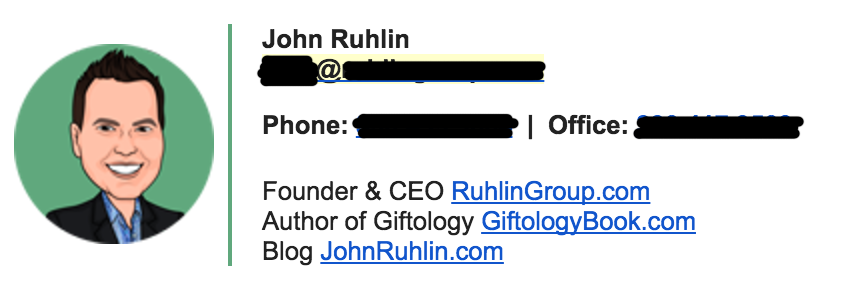
3) Add Your Book to Your Social Media
Once you’ve added your book to your email signature, it’s time to get it listed on your social media.
Which social networks are most effective will depend on where you are most active (and where your readership spends their time), but here are a few no-brainers:
- Change your main bio on LinkedIn to include the fact that you are now an author. This is the top thing people will see about you when they search you on LinkedIn, and you want to ensure that your book is front and center. In the example below, Jared Kleinert set his banner to his book title and included “Award Winning Author” in his LinkedIn bio to promote his book, 2 Billion Under 20.
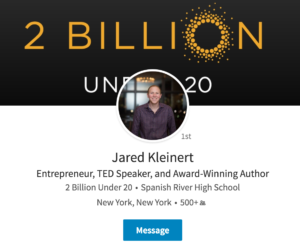
- Add the book to your LinkedIn profile as a “publication”. This will provide more detail about the book on your profile, and as an added bonus will also notify your connections of the book. Below is an example from Jay Kim, author of Hack Your Fitness.
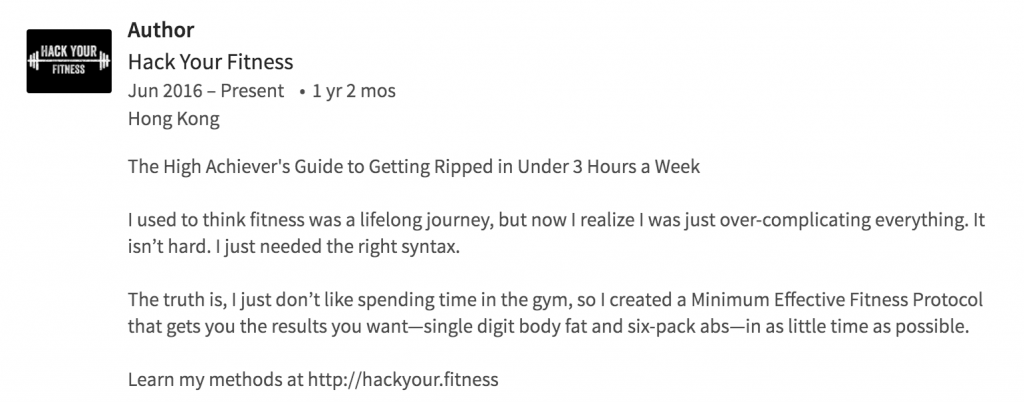
- Create a pinned tweet about your book so that it stays at the top of your Twitter profile. For everyone who lands on your Twitter page, would you rather they be greeted by your most recent tweet, or with information about your book? See the example from Geoff Blades below, where he includes a link to download 4 free chapters of his book, Do What You Want.
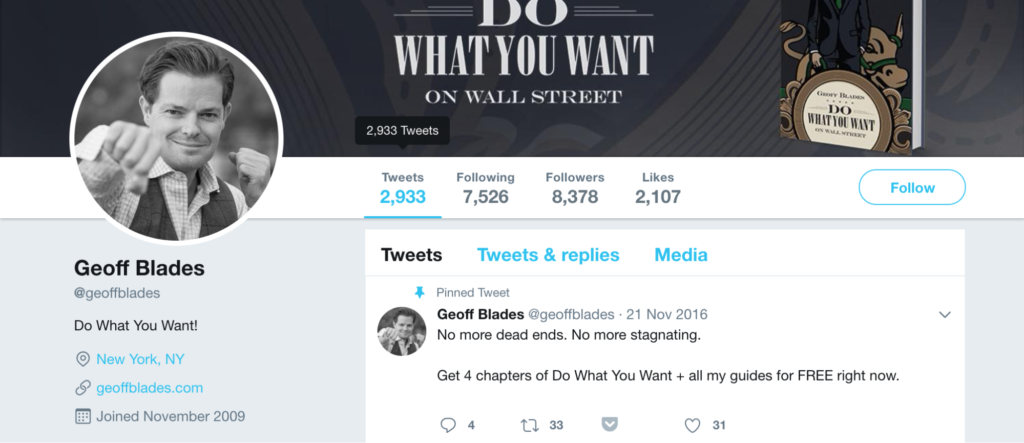
- Include the book in your Twitter bio. For many professionals, this is the most common bio that others come across online. Make sure it highlights your work (like Cameron Herold’s bio, which includes his three books: Double Double, Meetings Suck, and The Miracle Morning for Entrepreneurs).
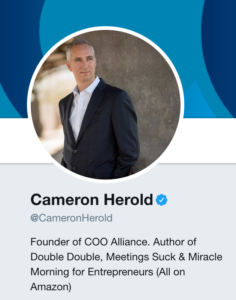
4) Set Your Content Marketing on Autopilot
Buying a book is a big step. Despite the relatively low price of a book, buyers are reluctant to dive into a book without building trust with an author first.
As a professional, your goal is not only to sell more copies of your book, but also spread your ideas freely and build up your reputation as an expert in your field.
One of the best ways to accomplish all of these goals is to give readers a shorter taste of your content for free.
Fortunately for you, this won’t require hours upon hours blogging. Since you just finished a book, you have tens of thousands of words of quality ideas to work from. All you need to do is make them online-ready.
Go through your book and pick out the 15 sections that provide valuable information and could stand alone as blog posts. Put them into separate documents, add an introduction and conclusion, do an edit, and voila — you’ve got 15 blog posts.
Set a weekly schedule to release one of these articles per week for the next four months. There are many places to post them, each with their own pros and cons, but for most professionals, the simplest and highest value place to post this content is on LinkedIn.
Simply click the “Write an Article” button on your homepage, load the article in, and release it to your followers.
To encourage book sales, add a link to your book at the end of each piece with a call to action to read more great content.
5) Become a Media Source
Most authors know that securing media attention is one of the keys to driving awareness to themselves and their book, and yet many aren’t sure exactly where to start to bring in the press.
There are many long term options available, but the first thing you should do is subscribe to HARO.
HARO (Help a Reporter Out) is a service that connects journalists with valuable sources for their stories. They write up a brief description of what they need, and HARO emails a collection of these briefs out to their sources three times a day. You can sign up to be one of these sources for free.
As an expert looking to get your name and book out there, this is an incredible opportunity.
Once you’ve subscribed to their emails, you can scan through them as they arrive and look for appropriate situations to provide insight. Respond to journalists with a concise pitch explaining your expertise (make sure to mention your book!) and if it’s a good fit, they’ll get back in touch to feature you in their articles.
It can be hard to break through on HARO, but it can also lead to some great opportunities. Last year, a response to a HARO inquiry landed me in the Wall Street Journal.
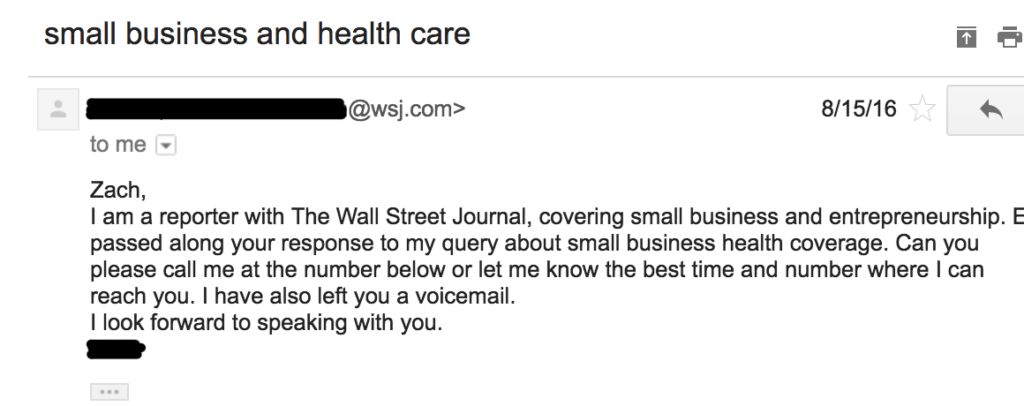
As the expert in your field (and a newly published author) you are a prime candidate to be featured by journalists. HARO is a low-commitment way to connect with the right journalists to make that happen.
Book marketing isn’t something to rush through and check off the list. As an author, your book is now a tool in your toolbelt, and book marketing will intertwine with your personal or business marketing for years to come.
But that lifelong journey starts with setting the right foundation. Following the steps in this article will help ensure that you start your future as an author on solid ground.


